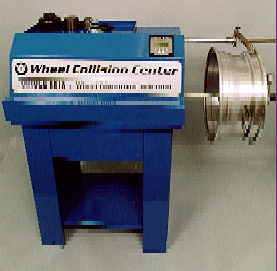To you and me, Pennsylvania's roads mean that if you live here and run less than a 55 or 50 series tire (and even that's pushing it), you'll be suffering the occasional bent wheel no matter how careful you are. If all this sounds familiar, it should; bent wheels certainly aren't unique to Pennsylvania's minefield roads. At the Wheel Collision Center in Bath, Pennsylvania, mangled wheels arrive daily by UPS from points as far away as Asia and Eastern Europe.
The most common reason for repairing a wheel is, of course, price. For instance, with E-36 M3 wheels running about $475 each on a good day, the prospect of repair for less than half that price is quite attractive whether to an insurance company faced with a claim, or to some poor sot who just bulls eyed a pothole and doesn't want to submit an insurance claim for fear of a premium increase, or worse. In addition to repairing bent wheels, the Wheel Collision Center also restores classic wheels that may be no longer available, such as the much sought-after 2002 and 3.0 CSL factory alloys. But the majority of the work is collision related.
Not so long ago, partners Daryl L. Robbins and George J. Herschman asked the entrepreneurial question, "Why is it that every part of a car can be repaired except for alloy wheels?" Robbins is a Harvard MBA, whereas Herschman is a master machinist. The two simply sniffed out a vast untapped market that was, until then, virtually monopolized by aftermarket wheel manufacturers and car manufacturers. Demand for wheel repair is largely unaffected by broad based economic trends, and that plays right into the Wheel Collision Center's business plan.
The processes by which the Wheel Collision Center performs their work involves use of machinery that is proprietary art in the patent-pending state of protection (Note: Patent was issued June 1997). This is legalese for "stuff that has to be kept under your hat." Therefore, it is understandable that we are limited in what we were allowed to photograph and explain, and a step-by-step description of a damaged wheel's journey through the facility cannot be printed at this time. But let me say this: While I'm not a machinist by any stretch of the imagination, I do know my way around a shop, and there are quite a few ingenious hand crafted machines at the Wheel Collision Center. In essence, the process involves application of controlled heat (varying temperature and exposure according to the metallurgy of the subject wheel) and controlled pressure.
When a damaged wheel arrives at WCC, the first step is to clean the wheel thoroughly and assess the extent of the damage. This is done, in part, on the Circle 9518 machine pictured here  which measures lateral and radial runout. The wheel is thoroughly scrutinized for cracks or bends, many of which may have predated the actual incident which prompted the owner or shop to send the wheel to WCC. The next step is to determine whether straightening or mere cosmetic work is required, or both. Paint removal is accomplished with a plastic medium blasted at the wheel with high pressure air. Welding and/or truing comes next, followed by surface prep and refinishing.
which measures lateral and radial runout. The wheel is thoroughly scrutinized for cracks or bends, many of which may have predated the actual incident which prompted the owner or shop to send the wheel to WCC. The next step is to determine whether straightening or mere cosmetic work is required, or both. Paint removal is accomplished with a plastic medium blasted at the wheel with high pressure air. Welding and/or truing comes next, followed by surface prep and refinishing.
During my brief visit, I observed all manner of wheels in various stages of repair. From extremely expensive Porsche Turbo alloys (the 10" wide ones with the air pressure sensor built in), to American muscle car wheels, to obscure and old European aftermarket stuff, even motorcycle alloys, each is treated with the same scientific methodology that results in a finely restored wheel. We photographed a rack full of new arrivals. Herschman anticipates having 99% of them on their way back to their owners within 2 days. For our money, the Wheel Collision Center presents an excellent alternative to replacement and a veritable bonanza for restorers. The repair market wouldn't exist without the unduly high prices charged for replacement alloy wheels. Economics at work; we love it.
-by Mike Miller